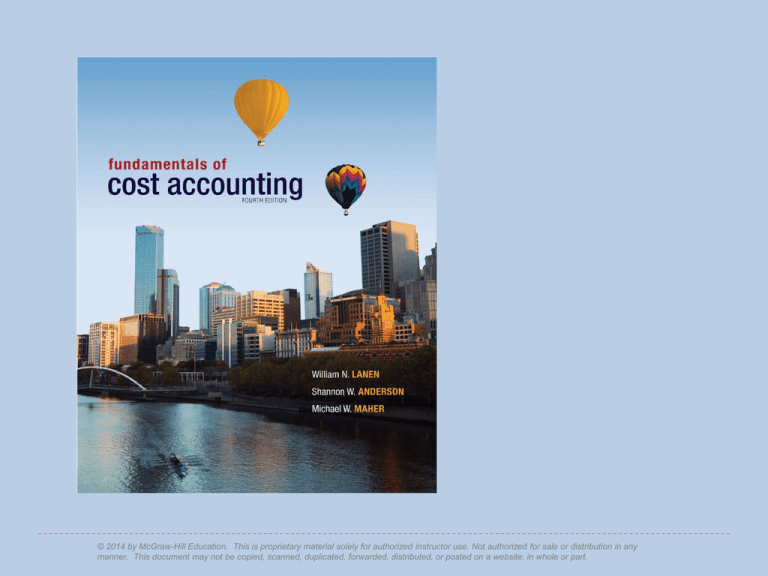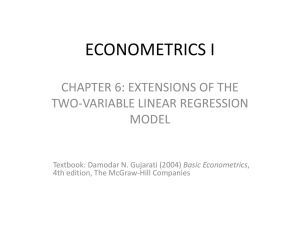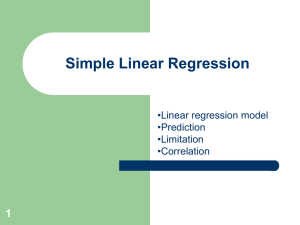
© 2014 by McGraw-Hill Education. This is proprietary material solely for authorized instructor use. Not authorized for sale or distribution in any
manner. This document may not be copied, scanned, duplicated, forwarded, distributed, or posted on a website, in whole or part.
Cost Estimation
Chapter 5
PowerPoint Authors:
Susan Coomer Galbreath, Ph.D., CPA
Charles W. Caldwell, D.B.A., CMA
Jon A. Booker, Ph.D., CPA, CIA
Cynthia J. Rooney, Ph.D., CPA
McGraw-Hill/Irwin
Copyright © 2014 by The McGraw-Hill Companies, Inc. All rights reserved.
Learning Objectives
LO 5-1
LO 5-2
LO 5-3
LO 5-4
LO 5-5
LO 5-6
LO 5-7
Understand the reasons for estimating fixed and variable costs.
Estimate costs using engineering estimates.
Estimate costs using account analysis.
Estimate costs using statistical analysis.
Interpret the results of regression output.
Identify potential problems with regression data.
Evaluate the advantages and disadvantages of alternative
cost estimation methods.
LO 5-8 (Appendix A)
Use Microsoft Excel to perform a regression analysis.
LO 5-9 (Appendix B)
Understand the mathematical relationship describing
the learning phenomenon.
5-3
Why Estimate Costs?
Managers make decisions and need to compare
costs and benefits among alternative actions.
Cost estimates can be an important element
In helping managers make decisions.
5-4
LO
5-1
Basic Cost Behavior Patterns
LO 5-1 Understand the reasons for estimating fixed and variable costs.
Costs
Fixed costs
Variable costs
Total fixed costs do not
change proportionately
as activity changes.
Total variable costs
change proportionately
as activity changes.
Per unit fixed costs
change inversely as
activity changes.
Per unit variable cost
remain constant as
activity changes.
5-5
LO
5-1
Methods Used to Estimate
Cost Behavior
Charlene, owner of Charlene’s Computer Care
(3C), wants to estimate the cost of a
new computer repair center.
1. Engineering estimates
2. Account analysis
3. Statistical methods
5-6
LO
5-2
Engineering Estimates
LO 5-2 Estimate costs using engineering estimates.
Cost estimates are based on measuring and
then pricing the work involved in a task.
Identify the activities involved:
– Labor
– Rent
– Insurance
Estimate the time and cost for each activity.
5-7
LO
5-2
Engineering Estimates
Details each step required to perform an operation
Permits comparison of other centers with similar operations
Costs for totally new activities can be estimated without
prior activity data.
Can be quite expensive to use
Based on optimal conditions
5-8
LO
5-3
Account Analysis
LO 5-3 Estimate costs using account analysis.
Review each account comprising the total
cost being analyzed.
Identify each cost as either fixed or variable.
Fixed
Variable
5-9
LO
5-3
Account Analysis
Costs for 360 repair-hours
Account
Total
Office rent
$ 3,375
Utilities
310
Administration
3,386
Supplies
2,276
Training
666
Other
613
Total
$10,626
Per repair hour
Variable
cost
Fixed
cost
$1,375
100
186
2,176
316
257
$4,410
$12.25
$2,000
210
3,200
100
350
356
$6,216
5-10
LO
5-3
Account Analysis
Fixed costs + (Variable cost/unit × No. of units) = Total cost
Cost at 360 repair-hours:
$6,216 + ($12.25 × 360) = $10,626
Cost at 480 repair-hours:
$6,216 + ($12.25 × 480) = $12,096
5-11
LO
5-3
Account Analysis
Managers and accountants are familiar with company
operations and the way costs react to changes in
activity levels.
Managers and accountants may be biased.
Decisions often have major economic consequences
for managers and accountants.
5-12
LO
5-4
Statistical Cost Estimation
LO 5-4 Estimate costs using statistical analysis.
Analyze costs within a relevant range, which is
the limits within which a cost estimate may be valid.
Relevant range for a projection is usually between
the upper and lower limits (bounds) of past activity
levels for which data is available.
5-13
LO
5-4
Overhead Cost Estimation
for 3C
Month
1
2
3
4
5
6
7
8
9
10
11
12
13
14
15
Overhead
costs
$ 9,891
$ 9,244
$13,200
$10,555
$ 9,054
$10,662
$12,883
$10,345
$11,217
$13,269
$10,830
$12,607
$10,871
$12,816
$ 8,464
Repairhours
248
248
480
284
200
380
568
344
448
544
340
412
384
404
212
These data will be used
to estimate costs using
a statistical analysis.
5-14
LO
5-4
Scattergraph
Does it look like a relationship exists
between repair-hours and overhead costs?
5-15
LO
5-4
Scattergraph
We use “eyeball judgment” to determine the
intercept and slope of the line.
5-16
LO
5-4
Hi-Low Cost Estimation
This is a method to estimate cost based on two cost
observations, the highest and lowest activity level.
Month
Overhead
costs
Repairhours
High
$12,883
568
Low
$ 9,054
200
Change
$ 3,829
368
5-17
LO
5-4
Hi-Low Cost Estimation
Variable cost per unit (V) =
(Cost at highest activity level – Cost at lowest activity level)
(Highest activity level – Lowest activity level)
Fixed cost (F) =
Total cost at
– (Variable cost × Highest activity level)
highest activity
Total cost at
– (Variable cost × Lowest activity level)
lowest activity
5-18
LO
5-4
Hi-Low Cost Estimation
Variable cost
($12,883 – $9,054)
$3,829
$10.40
=
=
=
per RH (V)
568 RH – 200 RH
368 RH
per RH
Fixed costs (F) = ($12,883 – ($10.40 × 568 RH) = $6,976
Fixed costs (F) = ($9,054 – ($10.40 × 200 RH) = $6,974
Rounding
difference
5-19
LO
5-4
Hi-Low Cost Estimation
How do we estimate manufacturing
overhead with 480 repair-hours?
TC = F + VX
TC = $6,976 + ($10.40 × 480) = $11,968
5-20
LO
5-4
Regression Analysis
Regression is a statistical procedure to
determine the relation between variables.
It helps managers determine how well the
estimated regression equation describes
the relations between costs and activities.
5-21
LO
5-4
Regression Analysis
Hi-low method:
Uses two data points
Regression:
Uses all of the data points
5-22
LO
5-4
Regression Analysis
Y = a + bX
Y = Intercept + (Slope × X)
For 3C:
OH = Fixed costs + (V × Repair-hours)
5-23
LO
5-5
Interpreting Regression
LO 5-5 Interpret the results of regression output.
Independent variable:
– The X term, or predictor
– The activity that predicts (causes)
the change in costs
Activities:
– Repair-hours
Dependent variable:
– The Y term
– The dependent variable
– The cost to be estimated
Costs:
– Overhead costs
5-24
LO
5-5
Interpreting Regression
The computer output of 3C’s scattergraph
gives the following formula:
Total overhead = $6,472 + ($12.52 per RH × No. of RH)
Estimate 3C’s overhead with 480 repair hours.
TC = F + VX
TC = $6,472 + ($12.52 × 480) = $12,482
5-25
LO
5-5
Interpreting Regression
Correlation coefficient (R):
This measures the linear relationship between
variables. The closer R is to 1.0 the closer the
points are to the regression line. The closer R is
to zero, the poorer the fit of the regression line.
Coefficient of determination (R2):
This is the square of the correlation coefficient.
It is the proportion of the variation in the dependent
variable (Y) explained by the independent variable(s) (X).
5-26
LO
5-5
Interpreting Regression
T-statistic:
This is the value of the estimated coefficient, b, divided
by its estimated standard error (Seb). Generally, if it is
over 2, then it is considered significant. If significant,
the cost is NOT totally fixed.
From the data used in the 3C regression, the t-statistic is:
t = b ÷ Seb
= 12.5230 ÷ 1.5843
= 7.9044
5-27
LO
5-5
Interpreting Regression
An 0.91 correlation coefficient means that a linear
relationship does exists between repair hours
and overhead costs.
An 0.828 coefficient of determination means that
82.8% of the changes in overhead costs can be
explained by changes in repair-hours.
Both have t-statistics that are greater than 2,
so the cost is not totally fixed.
5-28
LO
5-5
Multiple Regression
Multiple regression:
When more than one predictor (x) is in the model
Is repair-hours the only activity that drives
overhead costs at 3C?
Predictors:
X1: Repair-hours
X2: Parts cost
Equation:
TC = VC(X1) + VC(X2) + FC
5-29
LO
5-5
Multiple Regression Output
The adjusted R-squared is the correlation coefficient
squared and adjusted for the number of independent
variables used to make the estimate.
The statistics supplied with the output (rounded off) are:
– Correlation coefficient (R) = 0.953
– R2 = 0.908
– Adjusted R2 = 0.892
5-30
LO
5-5
Multiple Regression Output
TC = F + V1X1 + V2X2
TC = $6,416 + ($8.61 × 480) + (77% × $3,500)
TC = $13,244
5-31
LO
5-6
Practical Implementation
Problems
LO 5-6 Identify potential problems with regression data.
Effect of:
– Nonlinear relations
– Outliers
– Spurious relations
– Using data that do not fit the assumptions
of regression analysis
5-32
Practical Implementation
Problems
The Effect of Nonlinear Relations
$800
Assumed actual cost function
$700
$600
Cost
LO
5-6
$500
Regression
estimate
$400
$300
Relevant
range
$200
Capacity
$100
$0
0
5
10
15
20
25
30
35
40
Volume
5-33
LO
5-6
Practical Implementation
Problems
Problem:
• Attempting to fit a linear model to nonlinear data
• Likely to occur near full-capacity
Solution:
• Define a more limited relevant range.
(Example: from 25-75% capacity)
• Design a nonlinear model.
5-34
LO
5-6
Practical Implementation
Problems
The Effect of Outliers on the Computed Regression
Computed
regression line
“Outlier”
True regression line
5-35
LO
5-6
Practical Implementation
Problems
Problem:
Outliers move the regression line.
Solution:
Prepare a scattergraph, analyze the graph,
and eliminate highly unusual observations
before running the regression.
5-36
LO
5-6
Practical Implementation
Problems
The Effect of Spurious Relations
Problem:
Using too many variables in the regression
(i.e., using direct labor to explain materials costs).
Although the association is very high, actually
both are driven by output.
Solution:
Carefully analyze each variable and determine
the relationship among all elements before
using in the regression.
5-37
LO
5-6
Practical Implementation
Problems
The Effect of Using Data That Do Not
Fit the Assumptions of Regression
Problem:
If the assumptions in the regression are not
satisfied, then the regression is not reliable.
Solution:
There is no clear solution. Limit time to help
assure costs behavior remains constant,
yet this causes the model to be weaker
due to less data.
5-38
LO
5-6
Learning Phenomenon
Learning phenomenon is the systematic relationship
between the amount of experience in performing
a task and the time required to perform it.
5-39
LO
5-7
How an Estimation Method is Chosen
LO 5-7 Evaluate the advantages and disadvantages
of alternative cost estimation methods.
• Reliance on historical data is relatively inexpensive.
• Computational tools allow for more data to be used
than for non-statistical methods.
• Reliance on historical data may be the only readily
available, cost-effective basis for estimating costs.
• Analysts must be alert to cost-activity changes.
5-40
LO
5-7
Data Problems
• Missing data
• Outliers
• Allocated and discretionary costs
• Inflation
• Mismatched time periods
5-41
LO
5-7
Effect of Different Methods
on Cost Estimates
Estimated manufacturing overhead with 480 repair-hours.
Method
Total
Estimated
estimated
fixed
costs
costs
Estimated
variable
costs
Account analysis
$12,096
$6,216
$12.25/repair-hour
High-low
$11,968
$6,976
$10.40/repair-hour
Simple regression
$12,482
$6,472
$12.52/repair-hour
Multiple regression $13,244
$6,416
$8.61/repair-hour
+ 77% of parts cost
5-42
LO
5-8
Appendix A: Regression
Analysis Using Microsoft Excel
LO 5-8 (Appendix A) Use Microsoft Excel
to perform a regression analysis.
Many software programs exist to aid in performing
regression analysis.
In order to use Microsoft Excel, the Analysis Tool Pak
must be installed.
Data is entered and the user then selects the data and
type of regression analysis to be generated.
The analyst must be well schooled in regression in order
to determine the meaning of the output.
5-43
LO
5-9
Appendix B: Learning Curves
LO 5-9 (Appendix B) Understand the mathematical relationship
describing the learning phenomenon.
This is the systematic relationship between
the amount of experience in performing a task
and the time required to perform it.
Unit
First unit
Second unit
Fourth unit
Eighth unit
Time to
produce
100.0 hours
80.0 hours
64.0 hours
51.2 hours
Calculation
of time
(assumed)
80% × 100 hours
80% × 80 hours
80% × 64 hours
• Impact: It causes the unit price to decrease
as production increases.
• This implies a nonlinear model.
5-44
End of Chapter 5
5-45










